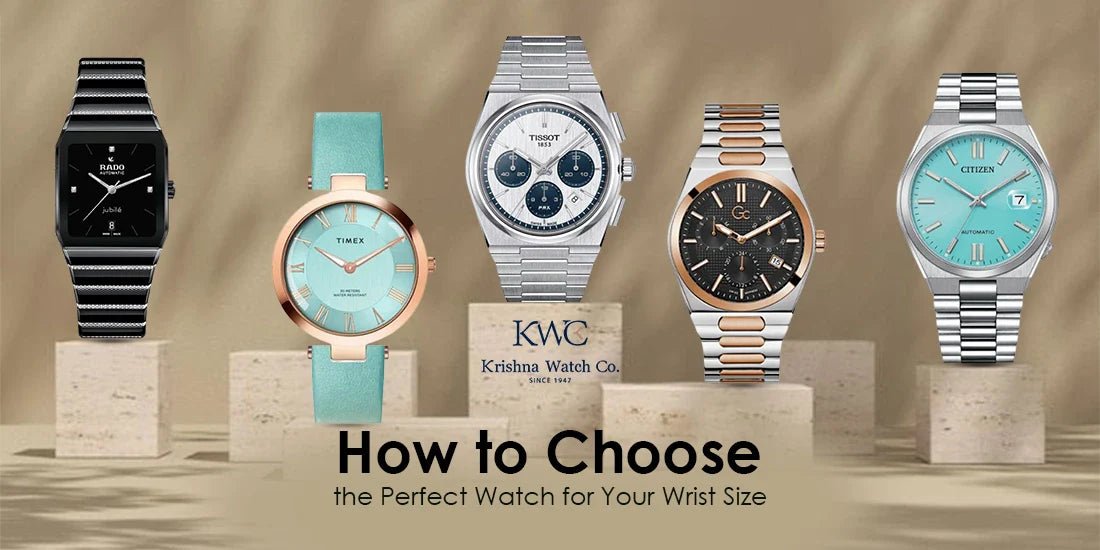A watch is like a punctuation mark for your wardrobe. It could be understated, eye-catching, iconic, or oversized. But the thing is, a watch only becomes great when it fits your wrist properly.
A watch should be thought of in terms of a handshake. If it is lacking firmness (too small), it is forgettable. If it is too strong (too large), there is often discomfort and an idea that it’s too much. The best watches get the proportions right, look personal and act with a purpose. And importantly - when you wear it it fits as if it is an extension of your style.
Whether you are a first-time buyer or a seasoned collector seeking to expand your collection, this guide will help you consider everything you want to know about a watch that fits your wrist, but more importantly, fits you.
Know Your Wrist Size: Start with the Basics

Before thinking about case shapes or strap materials, find your favorite soft measuring tape (or string) and measure your wrist right above the wrist bone (where your watch normally rests).
Here's a quick size reference:
Small wrist (5.5"–6.5"): Looks best with watches that have case diameter of 34mm up to 38mm.
Medium wrist (6.5"–7.5"): Can wear case sizes comfortably ranging from 38mm to 42mm.
Large wrist (7.5" and above): Look great with cases sized 44mm and up.
But size isn't just case diameter, the case thickness, lug-to-lug distance, and band width needs to be considered, too. A thick case will definitely look bulkier, while a longer lug-to-lug distance will hang over smaller wrists. Even watch bands need to complement the size of your wrist—a wide strap can feel excessive on smaller wrists.
Case Size, Shape, and Style: Precision With Personality
Now that you know your wrist size, let's discuss how the shape and style of the watch case impact the overall look.
Round Cases: The most traditional and versatile. Round watches can work with almost any wrist and style, from vintage to sport.
Square or Rectangular Cases: Square or rectangular cases offer a more modern, geometric look. They will usually complement wrists that are medium to large in size due to the shape and sharp lines.
Oversized (Bold Case) Watches: Oversized or bold watches are a statement piece and can be stylish, but also dramatically outsize smaller wrists. Choose oversized (bold) only if your wrist is reasonably large enough to handle the drama.
Watch Tip: A watch will appear well-balanced and proportional when it finds itself sitting comfortably in the edge of your wrist—no hang-over from the lugs, no gaps at the strap section, and the watch won't bulge above your risqué. Classic brands like Timex watches offer a wide variety of round and rectangular designs that cater to multiple wrist sizes while delivering timeless appeal.
Strap Smart: Comfort and Style Go Hand-in-Hand
Leather Straps: Lightweight, classy, and ideal for small to medium-sized wrist. It is a natural contour fit and also appropriate for dressy events.
Metal Bracelets: Metal bracelets offer a sturdy luxury feel and is often adjustable. Offers large holding and bold presence on the wrist with dimensions of larger wrists.
NATO & Fabric Straps: Casual, comfiest, and perhaps your 2nd option for style and personalization. Excellent for leisure or everyday wear, especially as the dimensions grow for a medium-sized wrist.
Rubber or Silicone Straps: Most widely offered strap material in sports and dive watches. Flexibility and waterproof traits make this a great choice for active pursuits.
Pro tip: If you have a small wrist, stay away from large dimension metal bracelets or think leather strap sizes. Get tapered or thin to your small wrist, remain in harmony. If you’re into tech-forward, minimalist designs, the Pebble smartwatch is a great example of a wearable that feels more like a natural extension than a gadget strapped to your wrist.
What Your Watch Says About Your Personality?

Your watch communicates more than just the time. It communicates something about yourself as well. Are you minimalist or an over achiever? Adventurous or business-oriented? Classic or modern?
The Minimalist: Minimalist watch styles are those that are elegantly simple, have clean design lines, but are mostly just meant to tell time. They have no bells and whistles. No fuss.
The Professional: The professional styles have chronographs, leather straps, formal finishes that coordinate with suits. They make wearers feel and look professional.
The Explorer: Explorer watches include pilot watches, dive watches and field watches. Think rugged, practical and if made right, very rewarding.
The Trendsetter: The trendsetter is about smart watches, vintage revived styles or bold colors that communicates their unique fashion style.
Knowing the size of your wrist helps narrow the options of what watch you can get. However, knowing your unique style brings you that much closer to finding your unique timepiece.
Conclusion
Choosing the right watch isn't about hopping on the latest trend or choosing an appropriate big name brand. It's about proportion, balance and style.
A watch that is sized correctly fits like a second skin, as opposed to being an object stuck to your wrist. It follows your wrist movement, compliments your outfit and above all, makes you feel like the best version of yourself.
The next time you catch yourself admiring a watch try and stop yourself. Ask: will this fit my wrist AND my life? If the answer is yes, congratulations. You have just found your next match.
Frequently Asked Questions
1. How can I measure my wrist size for a watch?
Answer: Get a flexible measuring tape or strip of paper and wrap it around your wrist just above the wrist bone, which is generally where you wear your watch. Then simply compare that measurement against standard wrist sizing tables.
2. What is the best watch case size for small wrists?
Answer: The best case size for small wrists (5.5 to 6.5 inches) is usually between 34mm to 40mm. Watches larger than 40mm can appear bulky and unbalanced on a thinner wrist.
3. Can oversized watches be worn on smaller wrists?
Answer: It is possible, but the watch should be appropriately slimmed down and short lugged to avoid overhang. A minimalist design can help, as can strap styles that compliment your wrist.
4. Which straps work best for different wrist sizes?
Answer: Leather straps and NATO straps for smaller wrists work best because they conform to the wrist and are easier to wear. Metal bracelets, are strongly preferred for larger wrist sizes, especially when fitted correctly around the wrist, which avoids sliding back and forth or sitting too tightly.
5. Is measuring lug-to-lug distance important?
Answer: Yes. Lug-to-lug distance is important. Lug to lug distance can help in actually seeing how a watch will sit on the wrist. If you have a smaller wrist, make sure you keep it under 48mm to avoid overextending watch over the edge of your wrist.







